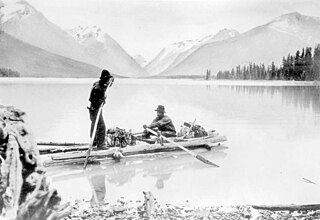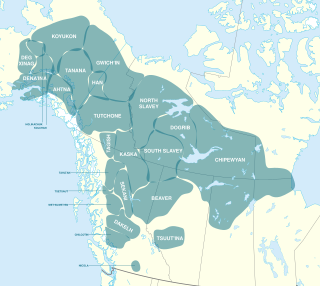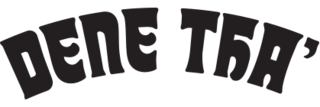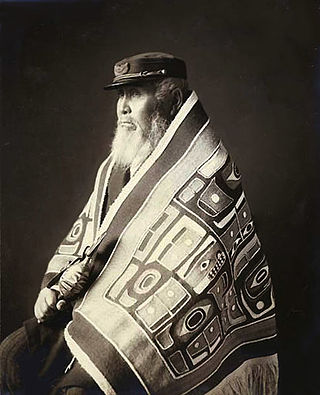Related Research Articles

Athabaskan is a large family of indigenous languages of North America, located in western North America in three areal language groups: Northern, Pacific Coast and Southern. Kari and Potter (2010:10) place the total territory of the 53 Athabaskan languages at 4,022,000 square kilometres (1,553,000 sq mi).

The Dene people are an indigenous group of First Nations who inhabit the northern boreal and Arctic regions of Canada. The Dene speak Northern Athabaskan languages. Dene is the common Athabaskan word for "people". The term "Dene" has two usages. More commonly, it is used narrowly to refer to the Athabaskan speakers of the Northwest Territories and Nunavut in Canada, especially including the Chipewyan (Denesuline), Tlicho (Dogrib), Yellowknives (T'atsaot'ine), Slavey, and Sahtu. However, it is sometimes also used to refer to all Northern Athabaskan speakers, who are spread in a wide range all across Alaska and northern Canada. The Southern Athabaskan speakers, however, also refer to themselves by similar words: Diné (Navajo) and Indé (Apache).

The Liard River of the North American boreal forest flows through Yukon, British Columbia and the Northwest Territories, Canada. Rising in the Saint Cyr Range of the Pelly Mountains in southeastern Yukon, it flows 1,115 km (693 mi) southeast through British Columbia, marking the northern end of the Rocky Mountains and then curving northeast back into Yukon and Northwest Territories, draining into the Mackenzie River at Fort Simpson, Northwest Territories. The river drains approximately 277,100 km2 (107,000 sq mi) of boreal forest and muskeg.
The Kaska language originated from the family of Athabaskan languages. Traditionally Kaska is an oral aboriginal language that is used by the Kaska Dena people. The Kaska Dene region consists of a small area in the Southwestern part of the Northwest Territories, the Southeastern part of Yukon Territory, and the Northern part of British Columbia. The communities that are in the Kaska Dene region are Fort Ware in N.W.T.; Ross River and Watson Lake in Y.T.; Dease Lake, Good Hope Lake, Lower Post, Fireside, and Muncho Lake in B.C. Kaska is made up of eight dialects, all of which have similar pronunciations and expressional terms. The town of Watson Lake was established around the period of the second World War when the Alaska Highway was first built in 1942. A major consequence of colonization was Kaska language loss. Another major cause of Kaska language loss in Canada was due to the Canadian Residential School System. The effect that these schools had on the Kaska language have caused a language gap between two generations resulting in few young speakers.

Sekani or Tse’khene are a First Nations people of the Athabaskan-speaking ethnolinguistic group in the Northern Interior of British Columbia. Their territory includes the Finlay and Parsnip River drainages of the Rocky Mountain Trench. The neighbors of the Sekani are the Babine to the west, Dakelh to the south, Dunneza (Beaver) to the east, and Kaska and Tahltan, to the north, all Athabaskan peoples. In addition, due to the westward spread of the Plains Cree in recent centuries, their neighbors to the east now include Cree communities.
First Nations in Alberta are a group of people who live in the Canadian province of Alberta. The First Nations are peoples recognized as Indigenous peoples or Plains Indians in Canada excluding the Inuit and the Métis. According to the 2011 Census, a population of 116,670 Albertans self-identified as First Nations. Specifically there were 96,730 First Nations people with registered Indian Status and 19,945 First Nations people without registered Indian Status. Alberta has the third largest First Nations population among the provinces and territories. From this total population, 47.3% of the population lives on an Indian reserve and the other 52.7% live in urban centres. According to the 2011 Census, the First Nations population in Edmonton totalled at 31,780, which is the second highest for any city in Canada. The First Nations population in Calgary, in reference to the 2011 Census, totalled at 17,040. There are 48 First Nations or "bands" in Alberta, belonging to nine different ethnic groups or "tribes" based on their ancestral languages.

The Tahltan or Nahani are a First Nations people of the Athabaskan-speaking ethnolinguistic group who live in northern British Columbia around Telegraph Creek, Dease Lake, and Iskut. The Tahltan constitute the fourth division of the Nahane.
The Kaska or Kaska Dena are a First Nations people of the Athabaskan-speaking ethnolinguistic group living mainly in northern British Columbia and the southeastern Yukon in Canada. The Kaska language, originally spoken by the Kaska, is an Athabaskan language.
Tagish was a language spoken by the Tagish or Carcross-Tagish, a First Nations people that historically lived in the Northwest Territories and Yukon in Canada. The name Tagish derives from /ta:gizi dene/, or "Tagish people", which is how they refer to themselves, where /ta:gizi/ is a place name meaning "it is breaking up.

Northern Athabaskan is a geographic sub-grouping of the Athabaskan language family spoken by indigenous peoples in the northern part of North America, particularly in Alaska, Yukon, and the Northwest Territories. The Northern Athabaskan languages consist of 31 languages that can be divided into seven geographic subgroups.

The Dene TháFirst Nation is a First Nations government of the South Slavey in Northern Alberta, Canada. The people call themselves Dene Dháa or 'Ordinary People' in the Dene Dháh language. Its population is centered primarily in three communities: Bushe River, Meander River, and Chateh, but approximately 600 members who live off-reserve. Dene Thá First Nation is Treaty 8 nation and a member of the North Peace Tribal Council.

The Indigenous peoples of the Pacific Northwest Coast are composed of many nations and tribal affiliations, each with distinctive cultural and political identities. They share certain beliefs, traditions and practices, such as the centrality of salmon as a resource and spiritual symbol, and many cultivation and subsistence practices. The term Northwest Coast or North West Coast is used in anthropology to refer to the groups of Indigenous people residing along the coast of what is now called British Columbia, Washington State, parts of Alaska, Oregon, and Northern California. The term Pacific Northwest is largely used in the American context.
Kaska may refer to:
The Kaska Dena Council is a tribal council formed of five band governments of the Kaska Dena people in northern British Columbia, Yukon Territory, and Northwest Territories, Canada.
The following is an alphabetical list of topics related to Indigenous peoples in Canada, comprising the First Nations, Inuit and Métis peoples.
Lhtako is the name of the tribe of Dakelh (Carrier) people who are today headquartered at Quesnel, British Columbia and incorporated under the Indian Act as the Red Bluff First Nation. Their southern neighbours are the T'exelc group of the Northern Secwepemc to the south, the Nazko people and Lhook'uz people to the west, the Tsilhqot'in peoples to the southwest, and the Lheidli Tenneh people to the north. Their territory borders with that of the Sekani on the northwest side of the Cariboo Mountains also. They are the southeasternmost of British Columbia's Athapaskan-speaking tribes.

Indigenous peoples of the Subarctic are the aboriginal peoples who live in the Subarctic regions of the Americas, Asia and Europe, located south of the true Arctic. This region includes the interior of Alaska, the Western Subarctic or western Canadian Shield and Mackenzie River drainage area, the Eastern Subarctic or Eastern Canadian Shield, Scandinavia, Western Russia and East Asia. Peoples of subarctic Siberia and Greenland are included in the subarctic; however, Greenlandic Inuit are usually classified as Indigenous peoples of the Arctic.

The Tanana Athabaskans, Tanana Athabascans or Tanana Athapaskans are an Alaskan Athabaskan peoples of the Athabaskan-speaking ethnolinguistic group. They are the original inhabitants of the Tanana River drainage basin in east-central Alaska Interior, United States and a little part lived in Yukon, Canada. Tanana River Athabaskan peoples are called in Lower Tanana and Koyukon language Ten Hʉt'ænæ, in Gwich'in language Tanan Gwich'in. In Alaska, where they are the oldest, there are three or four groups identified by the languages they speak. These are the Tanana proper or Lower Tanana and/or Middle Tanana, Tanacross or Tanana Crossing, and Upper Tanana. The Tanana Athabaskan culture is a hunter-gatherer culture and have a matrilineal system. Tanana Athabaskans were semi-nomadic and as living in semi-permanent settlements in the Tanana Valley lowlands. Traditional Athabaskan land use includes fall hunting of moose, caribou, Dall sheep, and small terrestrial animals, and also trapping. The Athabaskans did not have any formal tribal organization. Tanana Athabaskans were strictly territorial and used hunting and gathering practices in their semi-nomadic way of life and dispersed habitation patterns. Each small band of 20–40 people normally had a central winter camp with several seasonal hunting and fishing camps, and they moved cyclically, depending on the season and availability of resources.

The Indigenous peoples of Yukon are ethnic groups who, prior to European contact, occupied the former countries now collectively known as Yukon. While most First Nations in the Canadian territory are a part of the wider Dene Nation, there are Tlingit and Métis nations that blend into the wider spectrum of indigeneity across Canada. Traditionally hunter-gatherers, indigenous peoples and their associated nations retain close connections to the land, the rivers and the seasons of their respective countries or homelands. Their histories are recorded and passed down the generations through oral traditions. European contact and invasion brought many changes to the native cultures of Yukon including land loss and non-traditional governance and education. However, indigenous people in Yukon continue to foster their connections with the land in seasonal wage labour such as fishing and trapping. Today, indigenous groups aim to maintain and develop indigenous languages, traditional or culturally-appropriate forms of education, cultures, spiritualities and indigenous rights.
References
- 1 2 3 4 "Kaska Nation". Executive Council of British Columbia. 2009. Retrieved July 26, 2009.
- 1 2 3 4 "Kaska Tribal Council". Crown–Indigenous Relations and Northern Affairs Canada . Government of Canada. 2009. Retrieved July 28, 2009.
- ↑ "Facts for Kids: Kaska Indians (Kaskas)". www.bigorrin.org. Retrieved June 1, 2022.
- 1 2 3 4 5 6 7 Joseph., Honigmann, John (1949). Culture and ethos of Kaska society. Univ. Press. OCLC 33366126.
{{cite book}}: CS1 maint: multiple names: authors list (link) - 1 2 3 4 5 6 7 8 Honigmann, John Joseph; Bennett, Wendell Clark (1949). "Culture and ethos of Kaska society". Yale University Publications in Anthropology (40).
- ↑ "Our History". Kaska Dena Council. Retrieved June 1, 2022.
- 1 2 Moore, Patrick (November 1, 2018). "Shifting: Amerindian perspectivism in Kaska narrative performances". Language & Communication. Language in the Amerindian Imagination. 63: 33–48. doi:10.1016/j.langcom.2018.02.001. ISSN 0271-5309. S2CID 148727687.
- 1 2 3 4 Reconciliation, Ministry of Indigenous Relations and. "Kaska Nation". www2.gov.bc.ca. Province of British Columbia. Retrieved June 1, 2022.
- ↑ "Kaska Language Website". kaska.arts.ubc.ca. Retrieved June 1, 2022.
- 1 2 "Kaska | North American Indians". www.britannica.com. Britannica. Retrieved June 1, 2022.
- 1 2 "Kaska Dena". www.thecanadianencyclopedia.ca. Parks Canada. Retrieved June 1, 2022.
- ↑ "Treaty Info". Kaska Dena Council. Retrieved June 1, 2022.